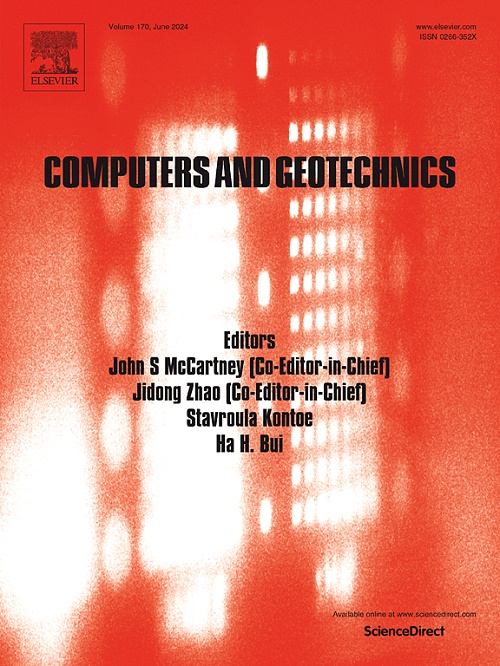Probabilistic investigation of the whole process of backward erosion piping for a two-layered levee in spatially variable soils
IF 5.3
1区 工程技术
Q1 COMPUTER SCIENCE, INTERDISCIPLINARY APPLICATIONS
引用次数: 0
Abstract
Backward erosion piping (BEP) at the base of levees is one of the main causes of levee failure. BEP typically occurs in two-layer levees systems and involves multiple stages throughout its development. While random field methods have been widely applied to model soil spatial variability, existing approaches predominantly focus on single-layer soil structures. Analyzing the impact of only single-layer spatial variability on piping development, especially during the initial uplift stage, may not adequately capture the complexities of actual conditions. To address this, this paper proposes a general framework that can be used to generate both single-layer or two-layer random field models. The Karhunen-Loève (K-L) series expansion method has been refined to generate two independent random fields, thereby facilitating the characterization of spatial variability in both the upper and lower soil layers. Monte Carlo Simulation (MCS) is employed to generate realizations of the random fields, which are then incorporated into numerical models to evaluate the effects of spatial variability on the whole process of BEP. The results show that single layer models tend to overestimate or underestimate the probability of piping initiation. The stage of backward erosion is influenced by the spatial variability of the upper and lower layered soil parameters. The single-layer random field model has a tendency to overestimate the probability of slope failure. In addition, the results of several stability analyses under the effects of extreme rainfall and upstream water level rise show that the probability of slope failure increases significantly during this process.
空间变土条件下双层堤防反冲管道全过程的概率研究
堤底反冲管(BEP)是堤防破坏的主要原因之一。BEP通常发生在两层堤防系统中,并且在其发展过程中涉及多个阶段。随机场方法已被广泛应用于模拟土壤空间变异性,但现有方法主要集中在单层土壤结构上。仅分析单层空间变异性对管道发展的影响,特别是在初始隆升阶段,可能无法充分反映实际情况的复杂性。为了解决这个问题,本文提出了一个通用框架,可用于生成单层或双层随机场模型。对karhunen - lo (K-L)级数展开方法进行了改进,生成了两个独立的随机场,从而便于表征上下层土壤的空间变异性。利用蒙特卡罗模拟(Monte Carlo Simulation, MCS)生成随机场的实现,然后将其纳入数值模型,以评估空间变异性对整个BEP过程的影响。结果表明,单层模型往往高估或低估了管道起爆的概率。上下层土壤参数的空间变异性影响着逆向侵蚀的阶段。单层随机场模型有高估边坡破坏概率的倾向。此外,在极端降雨和上游水位上升影响下的多次稳定性分析结果表明,在此过程中边坡破坏的概率显著增加。
本文章由计算机程序翻译,如有差异,请以英文原文为准。
求助全文
约1分钟内获得全文
求助全文
来源期刊

Computers and Geotechnics
地学-地球科学综合
CiteScore
9.10
自引率
15.10%
发文量
438
审稿时长
45 days
期刊介绍:
The use of computers is firmly established in geotechnical engineering and continues to grow rapidly in both engineering practice and academe. The development of advanced numerical techniques and constitutive modeling, in conjunction with rapid developments in computer hardware, enables problems to be tackled that were unthinkable even a few years ago. Computers and Geotechnics provides an up-to-date reference for engineers and researchers engaged in computer aided analysis and research in geotechnical engineering. The journal is intended for an expeditious dissemination of advanced computer applications across a broad range of geotechnical topics. Contributions on advances in numerical algorithms, computer implementation of new constitutive models and probabilistic methods are especially encouraged.
 求助内容:
求助内容: 应助结果提醒方式:
应助结果提醒方式:


